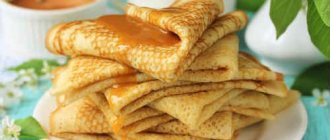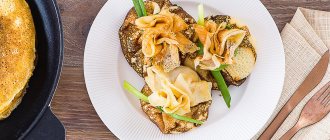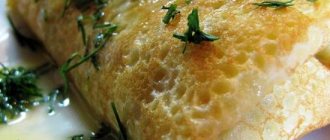Sometimes the pancakes turn out too dense, literally rubbery. Especially after they cool down. To prevent this from happening, it is recommended to listen to the advice of experienced chefs.
The quality of the finished pancakes depends on the frying temperature and the composition of the dough. The ratio of ingredients is crucial.
7 secrets why pancakes can turn out hard and rubbery:
- There is no or little baking powder (soda) in the dough.
- The density of pancakes is affected by the amount of flour. If there is a lot of flour component and few other ingredients, the pancakes will turn out dense and heavy. After cooling they become “rubbery”.
- A large number of eggs also makes the pancakes dense. The egg white is to blame for this. Eggs should be added only as a binding ingredient (1-2 pieces per liter of dough, no more).
- Batter that is too thick will result in thick, tough pancakes. If the pan is very hot, both sides of the pancake will quickly brown, but the inside of the product will remain half-baked.
- Pancakes will be rubbery in the center and brittle around the edges if little fat is used when cooking. It is recommended to add a sufficient amount of vegetable oil directly to the dough. Or apply it to the pan when baking each pancake.
- Butter will add softness to freshly baked pancakes. The finished pancakes are stacked on a plate. After adding every third or fourth pancake, a piece of hard butter is placed on it, which melts and is absorbed by those lying below.
- When preparing the dough, instead of milk, use yogurt, kefir, whey, sour cream, and fermented baked milk. Fermented milk products give pancakes volume and fluffiness.
Cooks recommend making pancakes using yogurt. This product contains aromatic additives and gives an unusual taste. Yogurt loosens the dough in the same way as yogurt and kefir.
TOP 5 recipes for pancakes [not rubber]
There are dozens of recipes for making pancakes. Experienced chefs can find both traditional and new recipes for making pancake dough.
Recipe with milk
This is a classic pancake recipe that produces tender and delicious pancakes.
✍ Ingredients:
- white wheat flour, premium - 300 g;
- milk - 0.75 l;
- 1-2 eggs;
- vegetable oil - a third of a glass (can be replaced with butter);
- granulated sugar - a tablespoon;
- soda - half a teaspoon (without top);
- salt to taste.
Preparation:
- Break eggs into a deep bowl, add soda, salt, sugar and beat the ingredients with a whisk.
- Add a glass of milk and beat the mixture again.
- Sift the required amount of flour and place it in a bowl.
- Knead the dough until smooth, trying to dissolve all lumps.
- Add the remaining milk and vegetable (or melted butter) oil and mix thoroughly.
- Leave the dough on the table (or in the refrigerator) for half an hour. During this time, the lumps will dissolve and the mass will become perfectly homogeneous.
- Mix the dough with a whisk again. Now it is ready for baking pancakes.
If you replace regular milk with baked milk, the pancakes will acquire a special, “rustic” taste. The aroma will be enhanced if the pan is greased with goose fat or a piece of unsalted lard.
On kefir [with video]
Fermented milk products allow you to bake beautiful openwork pancakes.
See also: How to cook dumplings in a kettle
✍ Ingredients:
- premium wheat flour - 2 cups;
- kefir - 0.4 l;
- 2 chicken eggs;
- a third of a glass of vegetable oil;
- water (boiling water) - 1 glass;
- half a teaspoon of baking soda;
- salt (to taste).
Preparation:
- In a large deep bowl, beat the eggs with a whisk.
- Pour kefir, add salt.
- Mix the ingredients thoroughly.
- Pour just boiled water into a glass and dissolve soda in it.
- Water is poured into the dough and kneaded quickly, trying to break up all the lumps.
- Cover the cup with a towel and leave for 5-7 minutes.
- Add vegetable oil and knead it. The dough is ready for frying pancakes.
How to turn pancakes so that they don’t tear in the pan - useful tips in the previous article.
Video recipe for pancakes with kefir
No eggs
Openwork and thin pancakes can be prepared without eggs.
✍ Ingredients:
- wheat flour (first or highest grade) - 300 g (20 tablespoons);
- glass of water;
- a glass of milk;
- vegetable oil - 6 tablespoons;
- salt to taste;
- a quarter teaspoon of baking soda;
- sugar - 2-4 tablespoons;
- a quarter teaspoon of table vinegar.
The dough contains a lot of water and will be liquid. Very thin pancakes are baked from it.
Preparation:
- Milk and water are poured into the pan.
- Add salt, sugar, vegetable oil and stir until dissolved.
- Measure out and pour in the pre-sifted flour.
- Knead the dough with a whisk or blender.
- Leave the pan for half an hour so that all the lumps dissolve.
- Place soda in a glass glass and pour vinegar. If necessary, mix the ingredients with a plastic spoon. Do not use metal objects, they react with acid!
- Add slaked soda to the dough, mix it thoroughly and start frying the pancakes.
The dough to which slaked soda is added should be baked immediately. If it sits for several hours, the quality of the pancakes will deteriorate and they will turn out flat and heavy.
By leaps and bounds [with video]
Yeast pancakes turn out porous and fluffy and never become “rubbery”. You can use both regular and instant yeast.
See also: Pancakes made with milk/kefir stick to the pan. What is missing?
✍ Ingredients:
- wheat flour (premium or 1st grade) - 2 cups;
- 6 grams of yeast Saf-moment (or others);
- a glass of milk;
- glass of water;
- 2 chicken eggs;
- 2 tablespoons of vegetable oil;
- half a glass of sugar;
- a pinch of salt.
Preparation:
- Break eggs into a large deep bowl, add salt and sugar.
- Beat the ingredients with a whisk until foam appears.
- Add warm water and slightly warmed milk.
- Yeast is measured on a kitchen scale and added to the bowl.
- Stir the ingredients with a whisk.
- Add flour and knead the dough until the lumps disappear.
- Place the pan in a warm place and keep in a warm place for an hour. During this time, bubbles appear in the dough, it rises and becomes thicker.
- Add vegetable oil and immediately bake pancakes. First, the frying pan is very hot, then the pancakes are fried over medium heat.
Video recipe for yeast pancakes from Irina Khlebnikova
Can't make pancakes? Look! (video)
To cope with the main problems that arise during baking pancakes, you need to analyze the quality of the pan used, the ingredients and the proportional composition of the kneaded dough. Once a weak point that interferes with the preparation of a dish has been identified, it must be eliminated using the tips described above.
It may also depend on the frying pan. On a heavy cast iron pan, I get golden-brown pancakes, but on a light one, made of thick aluminum, they turn out pale and have dry, brittle edges. I fry the same dough at the same time, but the pancakes come out different.
I haven’t baked pancakes for a long time, but my mother bakes pancakes all the time and they turn out golden brown and beautiful.
While I was learning to bake, the pancakes also turned out pale. When analyzing the ingredients of the recipe, it was found out that the pancakes are browned: milk (it is better to dilute the dough with milk alone), eggs (the more, the better) and sugar (the more, the better).
The addition of vegetable oil to the pancake dough also matters, as well as the quality of the frying pan and the strength of the fire on the burner. If the fire is slow and low, you won’t get a beautiful lace crust, you need to bake the pancakes over high heat, quickly turning them over, putting them on a plate and do not skimp on butter, coating each pancake. I also did this: before pouring the dough, I greased the frying pan with a piece of lard placed on a fork.
Perhaps pancakes are the only baked goods where I don’t like to save butter, so pancakes should be eaten this way, and they’re even tastier when dipped in melted butter.
Pancakes. Removing dryness and brittleness
It’s time to consider in great detail the painful topic: “why do pancakes turn out dry and brittle?” It is very important to understand why, and even more important to work on the mistakes and never face dryness and brittleness again. This can have a detrimental effect on reviews of your culinary abilities and the appetizing nature of the dish as a whole.
7 reasons why pancakes are hard?
And exactly the second you learn how to make pancakes that are not brittle or dry, you will begin to be overwhelmed by the thought of a pancake filling that can complement these unique delicacies. It is worth thinking not only about the hardness of each pancake, but also how many calories it contains.
1. Fry on too low a heat and the pancakes will just dry out instead of frying. Well, or fried until black.
2. Pancakes lack fermented milk products. Be sure to add kefir, yogurt or sour milk and then you can forget about hardness in pancakes once and for all.
3. Lots of eggs in the dough. Do not put more than 2 eggs per liter of milk. Excess protein (especially in country eggs) most often negatively affects the final condition of the pancakes.
4. Old or sub-prime flour . Pay attention to the cooking time of flour when purchasing. Evaluate the appearance of the flour before kneading, sift it, even if this is not stated in the recipe. Rub the flour lightly between your fingers (it should “squeak” a little).
5. Cooking pancakes in water . These pancakes will be rough and tough as a result. Use water only with milk (the proportion should be as close to 50/50 as possible). Such pancakes will be soft and delicate, thin and flavorful.
6. Lots of soda. Most often, this phenomenon occurs when various measures of weight and ratios in a recipe are neglected. Let's call this adding “by eye.” You can’t do this with soda; too much of it will dry out the pancakes and they will have an excessive taste of soda.
7. Do not grease the pan before each pancake. Even if the frying pan is Teflon and nothing ever sticks to it, grease it lightly with lard or butter.
But pancakes may not turn out at all, and in order to definitely avoid this, read and understand the root cause.
Pancakes come out dry
Dry ones can ruin everything. Above I cited seven main reasons for dryness in pancakes; from personal experience I can say for sure that most often pancakes are overdried during the cooking process. Some people want to give their pancakes a crunchy or blackish tint, others have subtracted the time for frying each side of the pancake and carefully monitor the stopwatch, regardless of your individual conditions in the kitchen and frying pan.
Understand that in a recipe, cooking time is a rather indirect concept and you must constantly adjust it for yourself. Prepare the first and second pancake based on the seconds from the recipe and visually monitoring the appearance of the pancakes. The resulting pancakes should be golden yellow, not dark brown.
The pancakes turned out dry and brittle. What should I do?
You can safely treat your loved ones to brittle and dry pancakes. You can coat the top with sweet jam and then no one will notice your mistake when frying pancakes. And the best thing is to just fix everything and eat super tasty and tender pancakes, how to do this? Easily!
- Be sure to cover the pancakes immediately after frying. The pancakes “steam” while they are hot, this steam under the lid will create a greenhouse effect and soften each pancake (dry edges will disappear, the pancakes themselves will become noticeably more tender)..
- Grease each pancake with butter immediately after frying. This is the second way to “soften” the dryness of pancakes. It can be used either separately or with a lid.
Are you still turning out dry pancakes? This means you didn’t carefully read all the words and warnings from Sanych. Fix everything quickly and forget about dryness and brittleness like a bad dream.
Pancakes tearing in a frying pan
One of the common problems of housewives is that pancakes do not want to turn over, they tear right in the pan, resulting in lumps and not pancakes. There are two main reasons for this failure. The first is that you did not put enough eggs in the dough, and the second is that you did not let the dough stand after kneading. Eggs add elasticity to the dough, so stick to the rule: at least three eggs per liter of liquid. What to do if the pancakes are torn, but the dough is already kneaded. Break one or two eggs into a bowl in a separate bowl, stir with a fork until smooth and pour into the dough, stir again with a mixer or ladle until smooth. You may need to add a little flour (starch) to return the desired thickness of the dough.
The second reason for an inelastic dough is that the gluten has not had time to develop enough to bind the ingredients together. Flour contains gluten, which makes our dough elastic, flexible, and homogeneous. It’s not for nothing that every pancake recipe ends with a recommendation - let the dough stand at room temperature for 20-30 minutes. It is especially important to follow this rule if you plan to wrap something in pancakes (after all, in this case they must be elastic!)
What other reasons could there be why pancakes tear?
little flour
If there is not enough flour, the dough can no longer be called dough. Are you trying to make the pancake batter as liquid as possible so that the pancakes turn out perfectly thin? Don't overdo this desire! If there is not enough flour, the pancakes will tear. Add flour and stir the dough well.
frying pan doesn't fit
It is not at all necessary to use special expensive pans for pancakes. But they must be perfectly smooth and clean. If the bottom of the pan clings even slightly to the dough, then it will be impossible to turn the pancake over without tearing. It will help the situation a little if you grease the pan every time before pouring the dough (this will also help the formation of holes). A special pancake frying pan will save you 100% from failure, because it has a surface to which the dough does not stick, in addition, a comfortable handle and light weight. A light frying pan can be quickly used while baking pancakes and your hand will not fall off after a stack of openwork suns.
early turning over
If the pancake is not cooked enough, it will definitely tear when turning it over. Let it brown well; readiness can be determined by the crispy, dry edges. Have a thin-based spatula on hand so you can lift the pancake and check for doneness.
too much oil
Butter or vegetable oil is added in many recipes to avoid greasing the pan every time you bake (and also to improve the taste). But like any fat, butter acts as a leavening agent for the dough, so it steals elasticity. Keep the amount of oil in the dough in moderation; you should not spend more than 1 tablespoon per liter of milk. To make holes appear, it is better to lubricate the surface of the frying pan with a drop of oil before each pancake.
a lot of baking powder
There are no leavening agents in my pancake recipes (only those that contain kefir), I think that it has no effect on the appearance of holes or on the taste, so I don’t see the point of adding it. But there are a huge number of recommendations according to which “without baking powder there will be no holes,” so recipes contain both baking soda and baking powder, sometimes all together. Remember that if you use too much baking powder, the pancakes may tear.
Why are pancakes tasteless?
no salt
Fresh food is always tasteless, and even pancake dough must be salted. The balance of salt and sugar creates a pleasant taste.
bad milk/kefir
There is a great temptation to save sour milk or expired kefir by making pancakes from them. If the products are so sour that they are already bitter or have unpleasant odors, you won’t get tasty pancakes. Milk from the store shelf often contains antibiotics, so when heated it begins to taste bitter.











